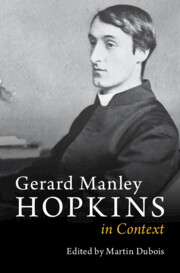Book contents
- Gerard Manley Hopkins in Context
- Gerard Manley Hopkins in Context
- Copyright page
- Contents
- Illustrations
- Notes on Contributors
- Note on Editions and Abbreviations
- Chronology
- Introduction
- Part I Places
- Part II Aesthetic and Cultural Contexts
- Part III Religious, Theological, and Philosophical Contexts
- Part IV Nature, Science, and the Environment
- Chapter 17 Ecology
- Chapter 18 Environmental Degradation
- Chapter 19 Energy Physics
- Chapter 20 Industry and Technology
- Part V Gender, Sexuality, and the Body
- Part VI Form, Genre, and Poetics
- Part VII Reception and Influence
- Further Reading
- Index
Chapter 19 - Energy Physics
from Part IV - Nature, Science, and the Environment
Published online by Cambridge University Press: 16 January 2025
- Gerard Manley Hopkins in Context
- Gerard Manley Hopkins in Context
- Copyright page
- Contents
- Illustrations
- Notes on Contributors
- Note on Editions and Abbreviations
- Chronology
- Introduction
- Part I Places
- Part II Aesthetic and Cultural Contexts
- Part III Religious, Theological, and Philosophical Contexts
- Part IV Nature, Science, and the Environment
- Chapter 17 Ecology
- Chapter 18 Environmental Degradation
- Chapter 19 Energy Physics
- Chapter 20 Industry and Technology
- Part V Gender, Sexuality, and the Body
- Part VI Form, Genre, and Poetics
- Part VII Reception and Influence
- Further Reading
- Index
Summary
This chapter outlines Hopkins’s knowledge of contemporary energy physics as it decisively shapes his distinctive poetry and the metaphysic that undergirds it. The discussion begins with Hopkins’s appreciation of meteorology in his ‘Heraclitean Fire’ sonnet, of the earth’s atmosphere as a vast thermodynamic system. The figure that this poem presents of man as a lonely ‘spark,’ and the pyrotechnics of ‘As kingfishers catch fire,’ ‘The Windhover’ and ‘God’s Grandeur,’ are then glossed through the optical application of the energy concept in spectroscopy. Finally the chapter considers field theory and Clerk Maxwell’s reassessment of the Newtonian principle of force through the energy concept as the distributive principle of stress, tracing Hopkins’s use of this physical concept in his writings on mechanics, nature and most momentously in the definitive formulation of his metaphysic of stress, instress ,and inscape in 1868 and the concurrent advent of his metrical principle of Sprung Rhythm.
Keywords
- Type
- Chapter
- Information
- Gerard Manley Hopkins in Context , pp. 165 - 173Publisher: Cambridge University PressPrint publication year: 2025

